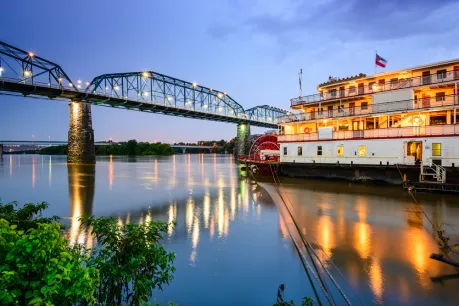Riverboat Accidents: What Injured Passengers, Crew, and Families Need to Know

Key Takeaways
- Many riverboat accidents trace back to preventable risks, like equipment failures, staffing decisions, or navigation errors, rather than purely sudden, unpredictable conditions on the water.
- Responsibility can involve operators, employers, or others connected to the vessel’s safety.
- Passengers, crew, and families each have options when injuries trace back to unsafe conditions.
- If you were harmed on a riverboat, our team can help explain your rights and next steps.
Injured?
A riverboat ride is supposed to be a pause from the world. But the moment a vessel shudders from a hidden strike or lurches toward a pier, everything changes at once. Passengers lose their balance, crew rush toward danger instead of away from it, and families waiting onshore are suddenly pulled into a situation they never imagined.
This guide is here for those caught in that moment. Riverboats may look peaceful, but the systems behind them can be complicated. Understanding how these incidents unfold is the first step toward understanding your options.
The River Environment: More Complex Than It Looks
River travel feels calm because so much of the danger lurks below the waterline.
When something goes wrong, it’s rarely because the river “acted up.” More often, it’s because a small, manageable risk wasn’t addressed in time, or several small factors converged.
- Shifting currents that nudge the vessel off its intended line.
- Debris carried in from upstream storms, sometimes hidden below the surface.
- Narrow channels and tight bridge clearances that reduce room for correction.
- Aging or poorly maintained equipment that doesn’t respond the way it should.
- Operational pressures, such as rushed schedules or understaffing, that affect decision‑making.
Alone, these issues aren’t dramatic, but together they can shape the outcome of a trip. Understanding that helps explain why these incidents are rarely as sudden or mysterious as they first appear.
Untangling Responsibility on the River
After an accident, the first explanation you often hear is that the river was unpredictable. And yes—water moves, weather shifts, visibility changes. But operators, owners, and employers are still responsible for preparing for those shifts.
Riverboat companies must maintain their vessels, train their crews, and navigate with reasonable care. Employers must make sure the people working on board have the equipment and staffing they need. Even dock owners and third-party contractors play a role when their structures or systems contribute to an unsafe situation.
Responsibility on the river can be layered. A mechanical failure might be connected to a neglected maintenance record, while a docking collision may trace back to staffing shortages or hours-long shifts. What matters is this: you don’t need to know which part failed or whose decision set it in motion. That’s something that becomes clearer once you’ve teamed up with the right lawyer.
Who May Have a Path Forward After a Riverboat Accident
Riverboat accidents can affect anyone connected to the vessel, whether they’re working, traveling, or waiting for someone to come home.
Passengers
Many passengers are tourists, travelers, or families looking for a quiet outing. When an operator’s decisions create unsafe conditions that lead to an injury, medical bills, interrupted travel plans, mobility limitations, and emotional distress all become part of the story.
Passengers may be able to seek compensation when their injury ties back to conditions that should have been made safe before the trip began.
Crew Members & Workers
Crew members often face hazards that appear without warning, whether from equipment that isn’t functioning properly or tasks that become risky under changing conditions.
When injuries arise from unsafe procedures, worn or faulty equipment, or avoidable operational decisions, workers may have protections and avenues for compensation, depending on their role and the waterway where the incident occurred.
Families After Fatal Incidents
When a riverboat accident results in a loss of life, families are left navigating grief and uncertainty at the same time. They may face unanswered questions about how the incident happened, why, and whether it could have been prevented.
In cases where negligence or unsafe conditions contributed to a fatal event, families may have options to pursue accountability and financial support.
How Accountability Is Established
After a riverboat accident, one of the first questions people ask is simple: Who should have prevented this? There are a few factors that typically help reveal whether risks were handled appropriately, including:
- How the vessel was operated: Logs can show speed, course changes, and whether the crew had to compensate for conditions they should have anticipated.
- Whether the equipment was maintained: Service records and repair histories help indicate if the vessel was in proper working order or overdue for attention.
- What conditions the operator was navigating: Weather reports, current data, and visibility information help clarify whether the crew planned for known challenges.
- What people on board witnessed: Photos, videos, and passenger or crew accounts help fill in gaps and confirm what was happening in the moments around the incident.
With the right support, these details come together to show not only what went wrong, but whether it could, and should, have been avoided.
Where Morgan & Morgan Makes a Difference
Riverboat cases can involve overlapping rules, industry practices that aren’t obvious to passengers or workers, and companies that understand the legal landscape far better than the people they serve. It’s a gap that leaves many victims feeling outmatched before they’ve even had a chance to gather their thoughts.
Morgan & Morgan was built to close that gap. Our 1,000+ trial-ready attorneys are backed with the resources of America’s Largest Personal Injury Firm, allowing them to take on any wrongful party that’s caused you harm – and go the distance.
Every river keeps moving, and so will your life after this. If you or someone you love was hurt on a riverboat, our team is here to help you understand your options and what accountability could look like moving forward.
Get started today with a free, no-risk case evaluation.
Frequently Asked Questions
1. Are riverboat accidents handled under maritime law or state law?
It depends on the waterway and the vessel’s operations. Some rivers are considered navigable and fall under maritime law, while others may involve state-specific rules. Our team can help determine which framework applies.
2. What if I didn’t realize I was injured until after I left the vessel?
This is common, as adrenaline and confusion can mask symptoms. Seek medical care as soon as you notice pain or mobility issues, and document your symptoms. You may still have options.
3. Can out-of-state or international visitors still bring claims?
Yes, many riverboat passengers are travelers. Your ability to pursue a claim doesn’t depend on living near the river where the incident occurred.
4. What if the operator blames “unpredictable river conditions”?
Conditions may change, but operators are expected to account for those shifts. Blaming the river doesn’t automatically remove responsibility.
5. Do seasonal or part-time riverboat workers have protections after an injury?
Often they do, depending on their role and employment structure. Maritime and workplace protections don’t disappear just because a position is temporary.
6. How soon should I reach out to a lawyer after a riverboat incident?
As soon as you’re able. Early guidance helps preserve information and clarify your options while details are still fresh.

We've got your back
Injured?
Not sure what to do next?
We'll guide you through everything you need to know.
